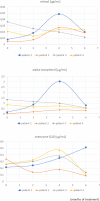Effect of Statin Therapy on the Plasma Concentrations of Retinol, Alpha-Tocopherol and Coenzyme Q10 in Children with Familial Hypercholesterolemia
- PMID: 33052507
- PMCID: PMC8770382
- DOI: 10.1007/s10557-020-07091-w
Effect of Statin Therapy on the Plasma Concentrations of Retinol, Alpha-Tocopherol and Coenzyme Q10 in Children with Familial Hypercholesterolemia
Abstract
Purpose: Familial hypercholesterolemia (FH) requires early treatment. However, statins, which are regarded the first-line therapy, have an influence on redox balance. Antioxidant vitamins are important for many metabolic processes in the developing body. There are few data available on the long-term safety of statin use in children. The aim of this study was to evaluate the influence of statin treatment in children with FH on plasma concentrations of antioxidant vitamins: retinol, alpha-tocopherol and coenzyme Q10.
Methods: The first study group consisted of 13 children aged 10-18 years treated with simvastatin for at least 6 months, and the second group comprised 13 age- and sex-matched children with hypercholesterolemia, in whom pharmacological treatment had not been applied yet. Analyses were performed using a high-performance liquid chromatograph coupled with a MS detector.
Results: The analysis did not reveal significant differences in the concentration of retinol, alpha-tocopherol or coenzyme Q10 between the studied groups. The adjustment of the concentrations of the vitamins to the cholesterol level also indicated no significant differences. We found no deficits in antioxidant vitamins in patients treated with statins, or any risk of adverse effects associated with an increase in their concentration.
Conclusion: There is no rationale for additional supplementation using antioxidant vitamins or modification of low-fat and low-cholesterol diet in pediatric patients treated with statins.
Keywords: Alpha-tocopherol; Children; Coenzyme Q10; Familial hypercholesterolemia; Retinol; Simvastatin.
© 2020. The Author(s).
Conflict of interest statement
The authors declare that they have no conflict of interest.
Figures


Similar articles
-
The effect of Simvastatin on the plasma antioxidant concentrations in patients with hypercholesterolaemia.Clin Chim Acta. 1997 Jul 4;263(1):67-77. doi: 10.1016/s0009-8981(97)06557-1. Clin Chim Acta. 1997. PMID: 9247729
-
HPLC method for simultaneous determination of retinol, alpha-tocopherol and coenzyme Q10 in human plasma.J Pharm Biomed Anal. 2006 Sep 18;42(2):232-6. doi: 10.1016/j.jpba.2006.03.037. Epub 2006 Jun 9. J Pharm Biomed Anal. 2006. PMID: 16765550 Clinical Trial.
-
Relationship between plasma coenzyme Q10, asymmetric dimethylarginine and arterial stiffness in patients with phenotypic or genotypic familial hypercholesterolemia on long-term statin therapy.Atherosclerosis. 2011 Sep;218(1):188-93. doi: 10.1016/j.atherosclerosis.2011.04.034. Epub 2011 May 5. Atherosclerosis. 2011. PMID: 21640350
-
HMG-CoA reductase inhibitors and coenzyme Q10.Cardiol Rev. 2005 Mar-Apr;13(2):76-9. doi: 10.1097/01.crd.0000154790.42283.a1. Cardiol Rev. 2005. PMID: 15705257 Review.
-
Statin Treatments And Dosages In Children With Familial Hypercholesterolemia: Meta-Analysis.Arq Bras Cardiol. 2018 Dec;111(6):810-821. doi: 10.5935/abc.20180180. Epub 2018 Oct 18. Arq Bras Cardiol. 2018. PMID: 30365601 Free PMC article.
Cited by
-
Essential Rule Derived from Thermodynamics and Kinetics Studies of Benzopyran Compounds.Molecules. 2023 Dec 11;28(24):8039. doi: 10.3390/molecules28248039. Molecules. 2023. PMID: 38138528 Free PMC article.
-
The antioxidant barrier, oxidative/nitrosative stress, and protein glycation in allergy: from basic research to clinical practice.Front Immunol. 2024 Dec 5;15:1440313. doi: 10.3389/fimmu.2024.1440313. eCollection 2024. Front Immunol. 2024. PMID: 39703514 Free PMC article. Review.
References
-
- Nordestgaard BG, Benn M. Genetic testing for familial hypercholesterolaemia is essential in individuals with high LDL cholesterol: who does it in the world? Eur Heart J. 2017;38(20):1580–1583. - PubMed
-
- Mysliwiec M, Walczak M, Malecka-Tendera E, Dobrzanska A, Cybulska B, Filipiak KJ, et al. Management in familial hypercholesterolaemia in children and adolescents. Position of the lipid expert forum. Kardiol Pol. 2013;71(10):1099–1105. - PubMed
-
- Goldberg AC, Hopkins PN, Toth PP, Ballantyne CM, Rader DJ, Robinson JG, et al. Familial hypercholesterolemia: screening, diagnosis and management of pediatric and adult patients: clinical guidance from the National Lipid Association Expert Panel on familial hypercholesterolemia. J Clin Lipidol. 2011;5(3 Suppl):S1–S8. - PubMed
-
- Grundy SM, Stone NJ, Bailey AL, Beam C, Birtcher KK, Blumenthal RS, et al. AHA/ACC/AACVPR/AAPA/ABC/ACPM/ADA/AGS/APhA/ASPC/NLA/PCNA Guideline on the Management of Blood Cholesterol: A Report of the American College of Cardiology/American Heart Association Task Force on Clinical Practice Guidelines. Circulation 2019. 2018;139(25):e1082–ee143. - PMC - PubMed
-
- Jellinger PS, Handelsman Y, Rosenblit PD, Bloomgarden ZT, Fonseca VA, Garber AJ, et al. American Association of Clinical Endocrinologists and American College of Endocrinology Guidelines for Management of Dyslipidemia and Prevention of Cardiovascular Disease - executive Summary. Complete appendix to guidelines available at http://journals.aace.com. Endocr Pract. 2017;23(4):479–497. - PubMed
Publication types
MeSH terms
Substances
Grants and funding
LinkOut - more resources
Full Text Sources
Medical
Miscellaneous

